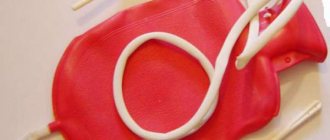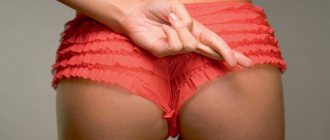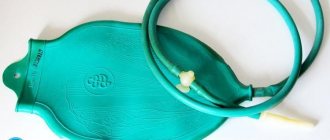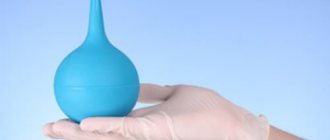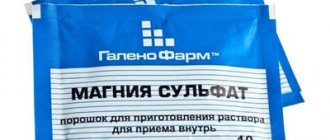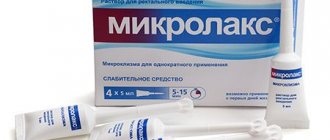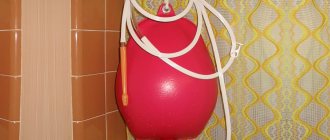Siphon enema (synonym: klistir) is a medical procedure in which liquid is injected into the intestines through the posterior opening. Enema is used for therapeutic and diagnostic purposes. In the article we will analyze the algorithm for placing an enema.
Klystir
Attention! In the pharmacological classification of ATC, laxative enemas in preparations are designated by the code A06AG.
Indications for use
Indications for placing an enema:
- Introduction of drugs into the bloodstream. This may be done in situations where it is undesirable or impossible to administer the medication by mouth. In addition, some antihypertensive drugs that are better absorbed without digestion can be safely administered by gentle enema.
- Local administration of drugs into the rectum. Corticosteroids and mesalazine, used in the treatment of inflammatory bowel disease, are administered this way. Using an enema avoids the passage of medication through the entire gastrointestinal tract, making it easier to deliver the drug to the affected area and limiting the amount that is absorbed into the bloodstream. Rectal corticosteroid enemas are sometimes used to treat mild to moderate ulcerative colitis. They may also be used together with systemic (oral or injectable) corticosteroids or other drugs to treat severe chronic inflammatory bowel disease (CIBD),
- In remote or rural areas, rectal fluids can be used to rehydrate a person.
Transanal irrigation (retrograde irrigation) is the regular use of water and irrigation equipment with a catheter at home to assist with bowel movements in people with bowel dysfunction.
Clyster is used during childbirth, but there is insufficient evidence for the effectiveness of this practice. Today it is not used everywhere.
Other indications for the use of clyster:
- As an intestinal stimulant, with the same purpose as a laxative. Laxatives are administered orally, while enemas are inserted directly into the rectum. The increase in fluid volume causes rapid expansion of the lower intestinal tract, which often results in very uncomfortable bloating, cramping, severe peristalsis,
- Emptying the rectum before colonoscopy, irrigoscopy, etc. Because of the speed and perceived convenience of enemas, they are used before diagnostic procedures that require a clean bowel,
- Clysters are also used to relieve constipation and in the treatment of impotence, although in the United States and some other parts of the world their use has been replaced in most professional medical settings by oral medications and rectal suppositories. It should be noted that an enema does not always help with constipation,
- Bowel stimulating enemas usually consist of water, which acts as a mechanical stimulant. They may also consist of water with baking soda (sodium bicarbonate). The solution draws extra water from the bloodstream into the colon, which makes the enema more effective, but can be quite unpleasant for the person. Mineral oil acts as a stool softener, but often causes unwanted effects.
Indications for performing a siphon enema and the essence of the procedure
The essence is to repeatedly rinse the intestines, for which a total of 10-12 liters of water are used. Manipulation is prescribed if there is no effect from a simple cleansing enema in the presence of the following indications:
- Chronic constipation, in which other methods of normalizing stool are not effective.
- Lack of therapeutic effect of laxative drugs.
- Preparation for surgery on the intestines, which requires deep cleaning.
- Intestinal volvulus, mechanical obstruction - prescribed for therapeutic and diagnostic purposes.
- Therapeutic cleansing of the intestines from waste and toxins, including after an infection.
The procedure involves repeated lavage of the intestines to remove toxins, feces, and food debris. The attending physician determines the indications.
Contraindications
Siphon enema is a medical procedure of medium complexity. Its placement leads to the patient’s psychological discomfort, unpleasant sensations, and the risk of complications. Manipulation cannot be performed if there are medical contraindications, which include:
- Hemorrhoids complicated by bleeding from the nodes.
- Acute inflammatory process in the tissues of the anus or mucous membrane of the rectum, lower gastrointestinal tract.
- Malignant or benign neoplasms localized in the rectum or colon.
- Cracks and erosions of the rectum.
- Formation of blood clots in the vessels of the mesentery.
- Gastrointestinal bleeding of various origins, including peptic ulcer with disruption of the integrity of the walls of the stomach or duodenum.
- Previous surgical interventions on the abdominal organs.
- Abdominal injuries of varying nature and severity.
Important! Carrying out the procedure against the background of contraindications increases the risk of severe complications and negative consequences several times.
Preparation for the procedure
A healthcare provider or doctor may ask the patient to change their diet or stop eating food 1-2 days before the enema. Instructions may vary depending on the treatment prescribed, personal needs and disease.
If the patient plans to administer an enema at home, you need to make sure in advance that all items are sterile. Particular attention should be paid to the type of enema. In some cases, you will have to mix the liquid with medications.
Important! To reduce the pressure felt in the colon, you need to empty your bladder before giving an enema. The patient can place a towel or cloth under themselves if fluid leaks from the intestines.
Features of performing a siphon enema
Things to take into account:
- Strong psychological impact on a person. The procedure takes from two to two and a half hours.
- Deep penetration of 40 cm inside causes discomfort, forcing the patient to remain motionless.
- Before the procedure, try to relax and distract the patient from unpleasant thoughts. Delicately present information about the upcoming manipulation.
- Well disinfected, sterilized instruments using antiseptic.
- The presence of a doctor at the first procedure is mandatory. The patient’s reaction is unpredictable, so to avoid complications, it is recommended that more than just nursing staff be present. The presence of a doctor will calm the patient and reduce anxiety.
Compliance with the requirements will give an excellent effect.
Execution technique and algorithm of actions
If the patient does not know how to perform an enema, it is recommended to seek help from a medical specialist. You can read the instructions for home kits that are available at your pharmacy. It is recommended to consult a doctor before use.
Some types of enemas are used exclusively in medical institutions. For example, a barium enema uses a liquid compound that accumulates in certain areas of the gastrointestinal tract. This increases the space that the doctor can see during the diagnostic procedure. Barium enemas are not used to treat constipation.
Procedure execution algorithm
An enema can be given at home, but you need to discuss this issue with your doctor in advance. A loved one can help with placing the clyster.
The enema is filled with water or a medicinal solution and placed in a bag on one side of the tube. The other part is lubricated and placed directly into the rectum. In order for the tube to reach the colon correctly, you need to press your knees to your chest while lying on your stomach or side.
Standard technique for performing a siphon enema:
- The enema bag is filled with the desired solution, such as warm water. Make sure the clamp is closed. The bag is held with the end of the hose down. The clamp is then opened for a few seconds to remove any air bubbles that may enter the intestine.
- The bag is hung next to the bathtub so that it can be accessed while lying on the left side,
- The end of the tube is lubricated with Vaseline and cream to make installation more comfortable. The patient lies on his left side and pulls his knees to his chest or gets on all fours, leaning on his elbows,
- You need to wait until the liquid begins to flow into the intestine,
- After the entire volume of liquid has been received, the enema is removed.
The patient may experience a strong urge to defecate. During a cleansing enema, you need to urgently go to the toilet to empty your bowels. The method cannot be used more than 2 times a week.
With the help of a siphon enema, a more effective cleansing of the intestines is achieved, since it is washed with water many times.
A siphon enema is a difficult manipulation, so it is necessary to monitor the patient’s condition.
Indications: 1) if other enemas are ineffective for constipation; 2) to remove poisons, toxins, products of fermentation and decay, mucus, pus from the intestines. 3) if intestinal obstruction is suspected; 4) preparing the patient for intestinal surgery
Contraindications: 1) bleeding from the gastrointestinal tract; 2) acute ulcerative-inflammatory processes in the rectum; 3) abdominal pain of unknown origin; 4) malignant tumors; 5) rectal prolapse; 6) massive swelling; 7) the first days after operations on the gastrointestinal tract.
Workplace equipment: 1) manipulation table;
Preparatory stage of performing the manipulation.
1. Before administering an enema, the nurse should change her gown and additionally put on an apron.
2. Carry out hygienic hand antiseptics and put on gloves.
3. Prepare the manipulation table.
4. Establish a trusting relationship with the patient.
5. Clarify the patient’s understanding of the purpose and course of the procedure, and obtain his consent.
6. Make sure that there are no contraindications to this procedure.
7. Cover the couch with oilcloth. the end of which hangs into the basin. put a diaper on top.
8. Place the patient on his left side. with knees bent and legs pressed to the stomach.
9. Connect the free end of the probe to the rubber tube using a glass adapter.
10. Lubricate the blind end of the probe to a distance of 5-6 cm with Vaseline oil.
The main stage of the manipulation.
11. Using the 1st and 2nd fingers of the left hand, spread the buttocks and carefully, with rotational movements, insert the blind end of the probe into the rectum to a depth of 20-30 cm.
12. Connect the funnel.
13. Lower the funnel to the level of the couch and hold it at an angle. Pour water along the wall of the inclined funnel until it is full, gradually leveling the funnel (so that air does not get into the intestines).
14. Slowly lift the funnel up, keeping an eye on it. so that the water level does not drop below the mouth of the funnel.
15. Lower the funnel down and wait until it is filled with intestinal lavage water,
16. Drain the rinsing water into a basin. (If necessary, take the 1st portion of rinsing water for bacteriological examination in a sterile container.)
17. Repeat the procedure until the rinsing water is “clean” (or as directed by a doctor)
18. Disconnect the funnel and the adapter with the rubber tube.
19. Leave the probe in the intestine for 10-20 minutes, lowering its free end into a basin to remove residual water from the intestine.
20. Remove the probe from the rectum.
21. Use a napkin to dry the skin around the anus. Inquire about the patient's condition.
22. Observe the patient for 10-15 minutes.
The final stage of the manipulation.
23. Rinse the system using a Janet syringe in the 1st container with a disinfectant solution with cleaning ability (desomix, etc.)
24. Disassemble the system and soak the rubber parts in the 2nd container with disinfectant solution, and time according to the instructions for use of this disinfectant.
25. Soak the glass adapter and funnel in the 3rd container with disinfectant solution for a while according to the instructions for use of this disinfectant
26. Pour rinsing water into the toilet, disinfect the basin. means, according to the instructions for use of this disinfectant.
(If viral hepatitis is suspected, cover the wash water with dry bleach 200g/kg for 90 minutes)
27. Place the diaper in a container for dirty laundry
28. Treat the manipulation table, apron, oilcloth, couch with a disinfectant by wiping
29. Take off your apron and gloves. Immerse gloves in the disinfectant solution for a time according to the instructions for using this disinfectant.
30. Change your robe, wash your hands with soap, dry with a towel
Note:
(The installation of a siphon ENEMA should be carried out with an assistant and in the presence of a doctor. 2. For persistent constipation, it will not be possible to insert the probe 20-30 cm, so it is necessary to make a mark 30 cm from the blind end. Insert the probe to a possible depth, moving it to the mark as you cleanse intestines
GASTRIC WASHING
The first aid for acute poisoning with large doses of drugs taken orally, poor quality food, alcohol, mushrooms, etc. is gastric lavage. Many patients do not tolerate the insertion of the probe. The reason for this is an increased cough or gag reflex, high sensitivity of the mucous membrane of the pharynx and esophagus.
If, when the probe is inserted, the patient begins to cough, choke, or his face becomes cyanotic, the probe should be immediately removed, since it has entered the larynx or trachea, and not the esophagus.
If gastric lavage for food poisoning is done several hours after poisoning and there is reason to assume that part of the bad food is already in the intestines, complete gastric lavage by administering a saline laxative through a tube.
Indications: 1) poisoning by poisons, poor quality food, drugs, alcohol; 2) chronic gastritis with increased mucus formation; 3) narrowing of the pylorus: 4) intestinal obstruction.
Contraindications: 1) bleeding from the gastrointestinal tract;
Workplace equipment : 1) manipulation table: 2) sterile thick gastric tube;
Features of siphon enema
Many experts consider the procedure to be an outdated method of colon cleansing. Despite its effectiveness, siphon enema is more traumatic than other types of enemas.
The procedure is only performed in a hospital if other cleansing methods, such as laxatives or enemas, are ineffective.
First, the doctor conducts a survey and examination of the patient, and after that the procedure is performed according to a clear scheme. Any deviation from the established technology is fraught with complications. Flushing allows you to cleanse the entire colon area. During the procedure, water is poured in and out forcibly, cleansing the lower intestine.
